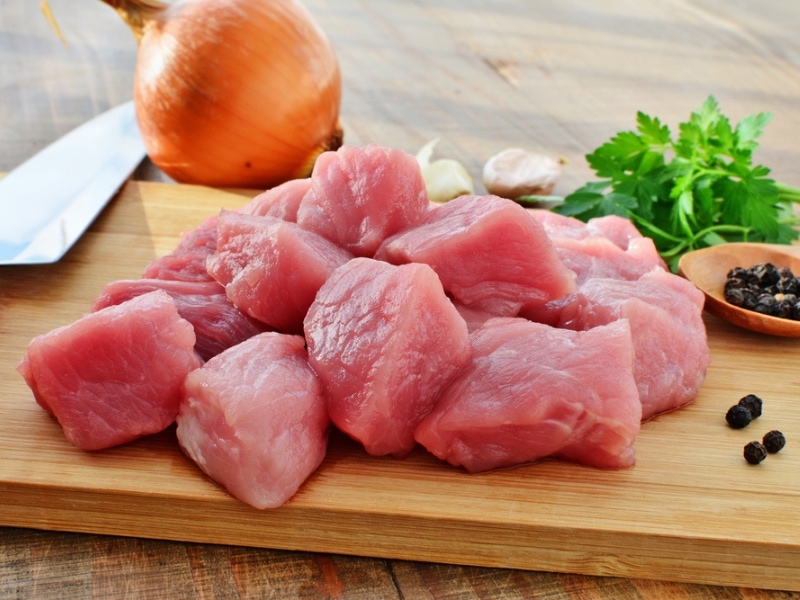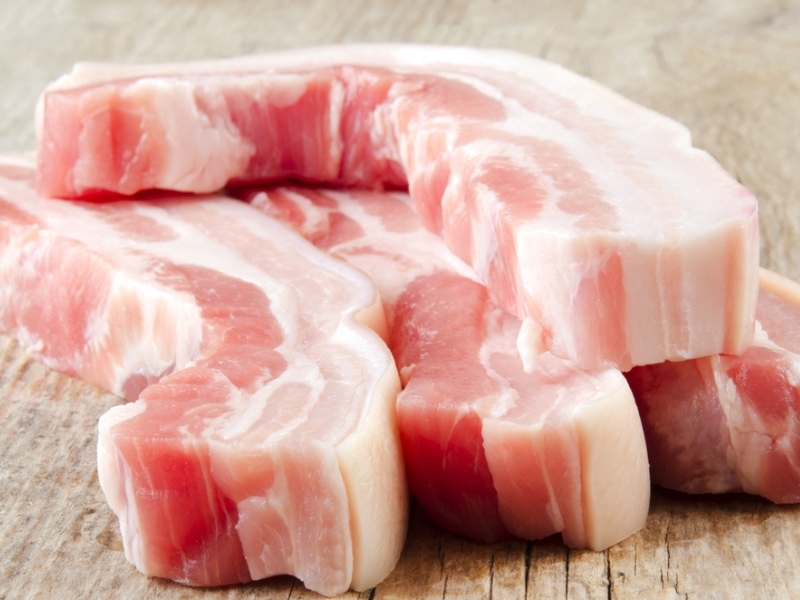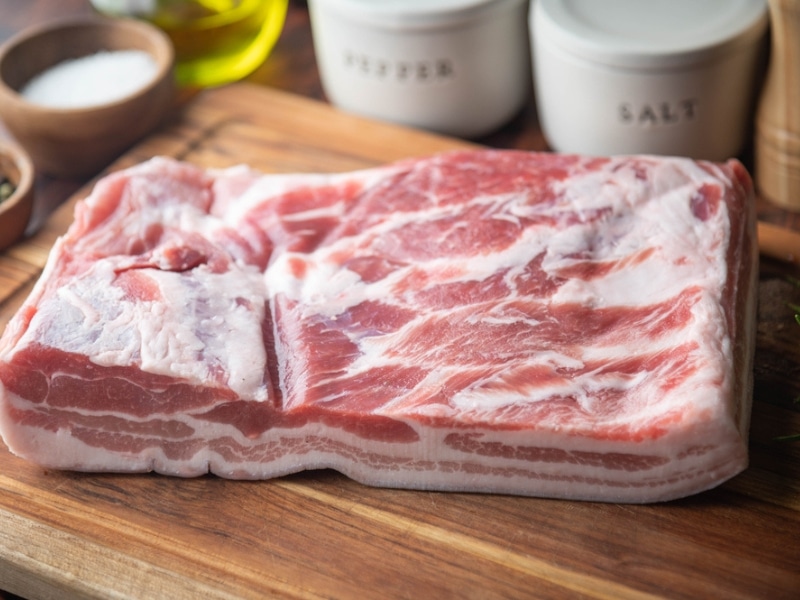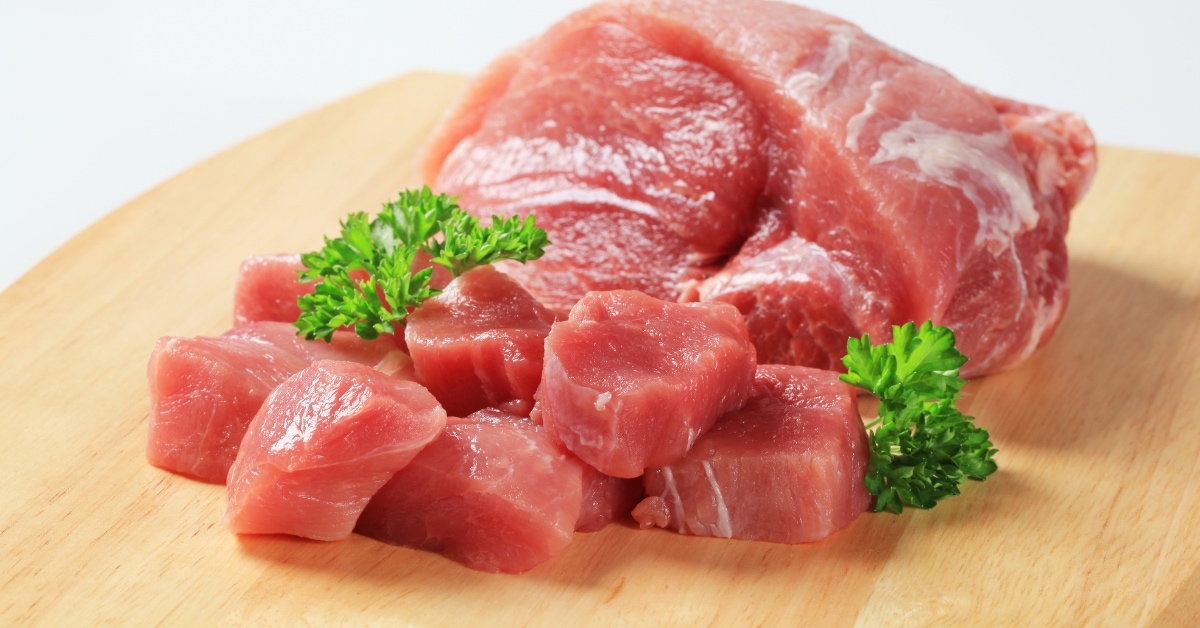There are five easy ways to tell if pork has gone bad. It all comes down to color, smell, texture, expiration date, and how the meat appears after cooking.
Checking for mold is always important, too!
If you have any doubts about the freshness of the pork, it’s safer to discard it rather than risk foodborne illness.

Always store and handle pork properly to maximize its shelf life.
These handy guidelines will help keep you safe, happy, and satisfied in the kitchen.
How to Tell If Pork Is Bad
Here’s what to look for to tell if pork has gone bad:
- Smell: The first and most obvious sign is a foul smell. If it has a sour or ammonia-like odor, it’s spoiled and should be discarded.
- Color: Fresh pork should be pink or light red in color. If it has turned gray or brown, it’s past its prime.
- Texture: Good pork should be firm to the touch and not slimy or sticky. If the meat feels mushy or off, discard it.
- Expiration date: Always check the expiration or “sell by” date on the packaging of the pork. If the date has passed, get rid of the meat.
- Cooking: If you’re cooking pork and notice an unusual smell, it’s gone bad. Or if the meat is tough and chewy after cooking, it’s spoiled and should not be consumed.
It’s important to remember consuming spoiled meat can cause food poisoning. Stay on the safe side and discard any meat you suspect has gone bad.
What Makes Pork Go Bad?
Pork, like any other type of meat, can go bad due to various factors. Here are some of the most common causes of pork spoilage:
- Bacteria: Bacteria are the primary cause of pork spoilage. They can grow on the surface of the meat or inside it. This leads to spoilage and the production of harmful toxins.
- Oxygen exposure: When pork is exposed to air, the oxygen causes the fats in the meat to oxidize. This leads to rancidity and spoilage.
- Improper storage: If pork is stored at the wrong temperature or for too long, it spoils faster. This causes bacteria to grow rapidly, resulting in spoilage.
- Contamination: If pork comes into contact with other contaminated surfaces or meats, it leads to spoilage. This is because of the growth of harmful bacteria.
- Exposure to light: Light can cause the breakdown of certain compounds in pork, leading to spoilage and off-flavors.

How Long Before Pork Goes Bad?
The length of time before pork goes bad varies depending on the type of pork and how it’s stored. Here are some general guidelines:
- Cooked pork: Cooked pork will last in the refrigerator for 3 to 4 days. It’s important to store cooked pork in an air-tight container. Or, wrap it tightly in plastic wrap or aluminum foil. This prevents bacteria growth and moisture loss. Leftover pork can also be frozen for up to 2 to 3 months.
- Fresh pork: Fresh pork should be consumed within 3 to 5 days of purchase. Store it properly in the refrigerator at a temperature of 40°F or below.
- Frozen pork: Frozen pork can last up to 6-12 months if it’s stored correctly in the freezer. However, the quality of the pork will start to deteriorate.
It’s important to note these are general guidelines. The amount of time before pork goes bad is dependent on many factors. These include the storage temperature, cut of meat, and method of preparation.
Use your senses to check for any signs of spoilage before consuming pork.
What Happens If You Cook Bad Pork?
Cooking bad pork won’t make it safe to eat. If the pork is already contaminated with harmful bacteria or toxins, cooking it will kill the bacteria. But it won’t eliminate the toxins produced.
Consuming these toxins can still lead to food poisoning and various health problems, even if the pork is thoroughly cooked.
Cooking pork that has gone bad isn’t effective in killing all of the bacteria present. Some types of bacteria survive at high temperatures and thrive in a low-acid environment like meat.
Consuming these bacteria can lead to food poisoning and other health issues, even if the pork has been cooked.

What Happens If You Eat Bad Pork?
Eating bad pork can lead to food poisoning and various health problems.
Spoiled pork can contain harmful bacteria such as Salmonella, Listeria, and E. coli. These can cause nausea, vomiting, diarrhea, stomach cramps, fever, and dehydration.
In severe cases, food poisoning from bad pork can lead to hospitalization and even death.
Some people are especially vulnerable. They include young children, elderly people, pregnant women, and those with weakened immune systems.
Consuming pork contaminated with parasites such as Trichinella spiralis can lead to a condition known as trichinellosis. It causes muscle pain, fever, fatigue, and swelling of the eyelids and face.
The Pork Smells Bad But It’s Not Expired
Pork might smell bad even though it’s not expired. This shows the meat has started to spoil or has been contaminated by bacteria.
It’s possible the pork was not stored properly. Or it could be a sign of bacterial growth during the processing or handling of the meat.
Discard the pork to prevent any potential health risks associated with consuming spoiled meat.
Always inspect pork before cooking and consuming it. Be sure to trust your senses to determine if it’s safe to eat.

How to Keep Pork Fresh for Longer
Here are some tips on how to keep pork fresh for longer:
- Proper storage: Store fresh pork in the refrigerator at a temperature of 40°F or below. Keep the pork in its original packaging or wrap it tightly in plastic wrap or aluminum foil. Or, store the pork in an air-tight container or resealable plastic bag.
- Freeze the pork: If you’re not planning to consume the pork within a few days, freeze it. Freezing pork can extend its shelf life for up to 6-12 months. To freeze pork, wrap it tightly in plastic wrap or aluminum foil and store it in an air-tight container or resealable plastic bag. Be sure to label the container or bag with the date of freezing.
- Use a vacuum sealer: A vacuum sealer helps remove air from the packaging. This can help prevent freezer burn and extend the shelf life of the pork.
- Marinate the pork: Marinating pork helps enhance its flavor and keeps it fresh. Acidic ingredients in marinades, such as vinegar or citrus juice, help inhibit the growth of bacteria.










